Roads
A gateway to the North, Pangasinan is accessible through the following major thoroughfare: 1) Manila North Road; a north to south backbone that extends from Carmen, Rosales up to the Municipality of Sison; 2) the Romulo Highway via Tarlac; 3) the Pangasinan-Zambales Road (Olongapo-Alaminos-Bugallon road) connecting the province of Zambales in Region III; 4) Pangasinan-Nueva Ecija Road (Rosales-Umingan Road) which links Pangasinan to Nueva Ecija; 5) Pangasinan-Nueva Vizcaya Road (Camiling-Wawa-Bayambang-Malasiqui-Sta. Barbara Road); 6) Pangasinan-La Union Road, linking Pangasinan to province of La Union; and 7) Tarlac-Pangasinan-La Union Expressway (TPLEx).
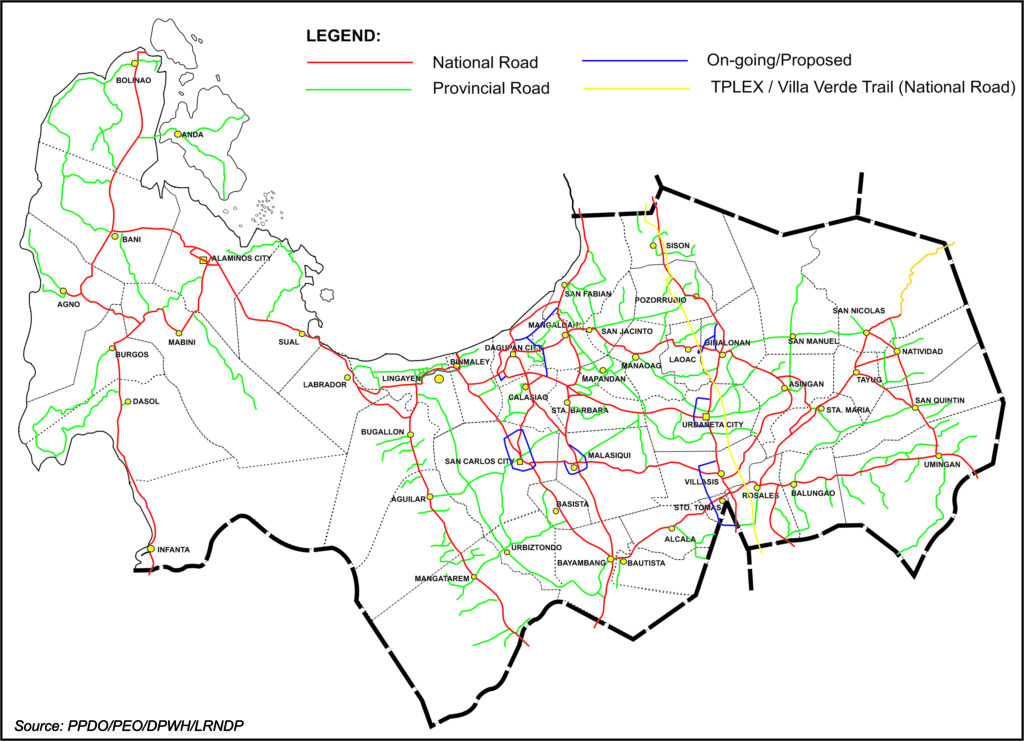
The total road length of the province for the year 2020 is 8,451.5404 kms. National Road recorded 630.1850 kilometers representing 7.46% of the total road length of Pangasinan, Provincial Road with 727.7270 kilometers or 8.61%, Municipal Road with 657.7980 kilometers or 7.8%, and Barangay Roads which has the longest with 6,435.8304 kilometers or 76.1% share of the total provincial road length.
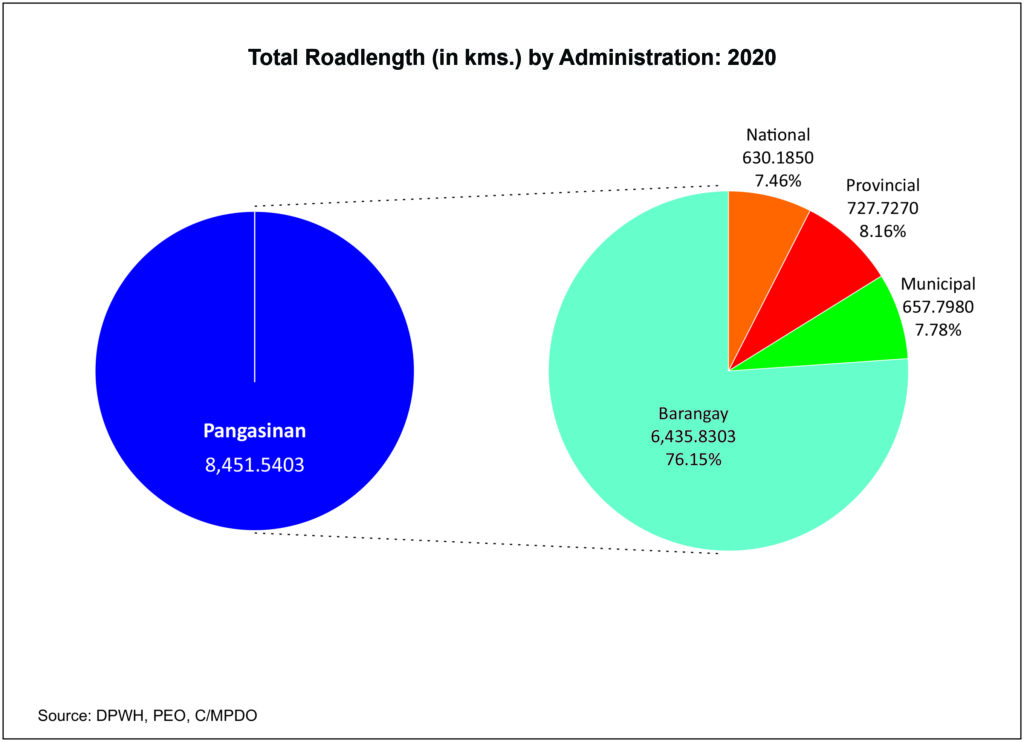
In terms of road density, Pangasinan has a road density of 1.55 km/sq.km of its total land area and 2.67 km/1,000 populations (2020 projected), which is still adequate compared to the standards of 1.0 km/sq. km. and 1km/1,000 population.
Bridges
The province’s total length of bridges is 37,614.07 linear meters. National Bridges recorded the longest (by Administration) with a total of 14,110.16 linear meters, which is about 37.51% of the total province’s bridge length. Provincial Bridges has 5,802.50 linear meters or about 15.43%, Municipal Bridges with 3,480.92 linear meters or 9.25%, and Barangay Bridges with 14,220.49 linear meters or 37.81%.
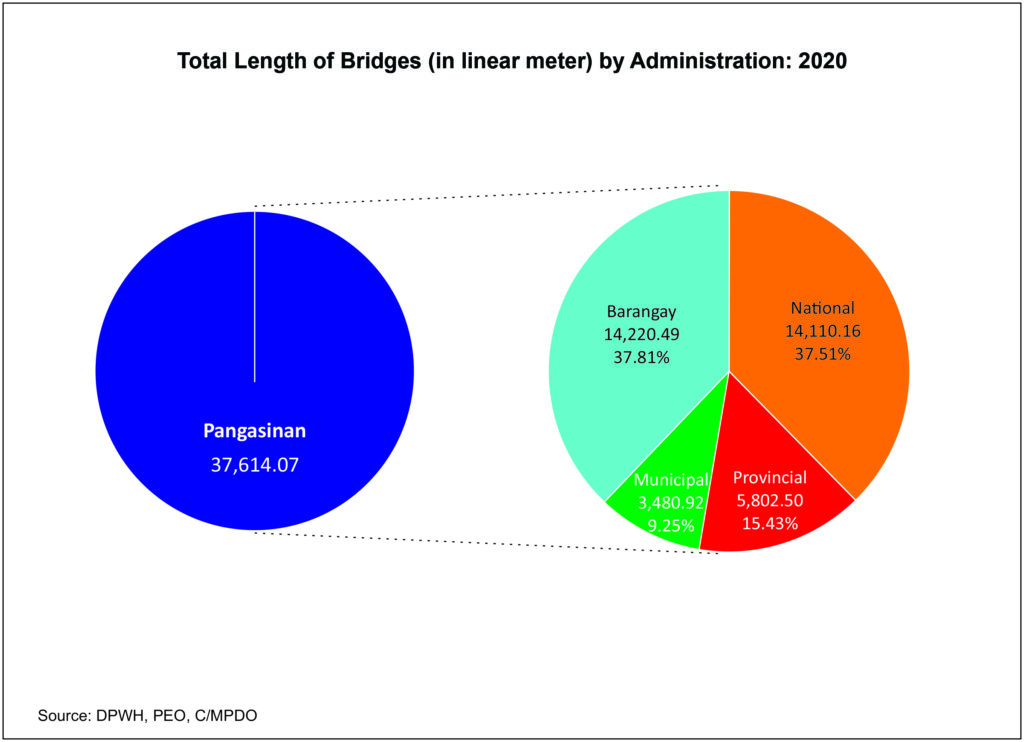
District VI has the longest bridge length with 10,069.19 linear meters or 26.77% of the total province’s bridge length, while District V has the least with 4,187.78 linear meters or about 11.13%.
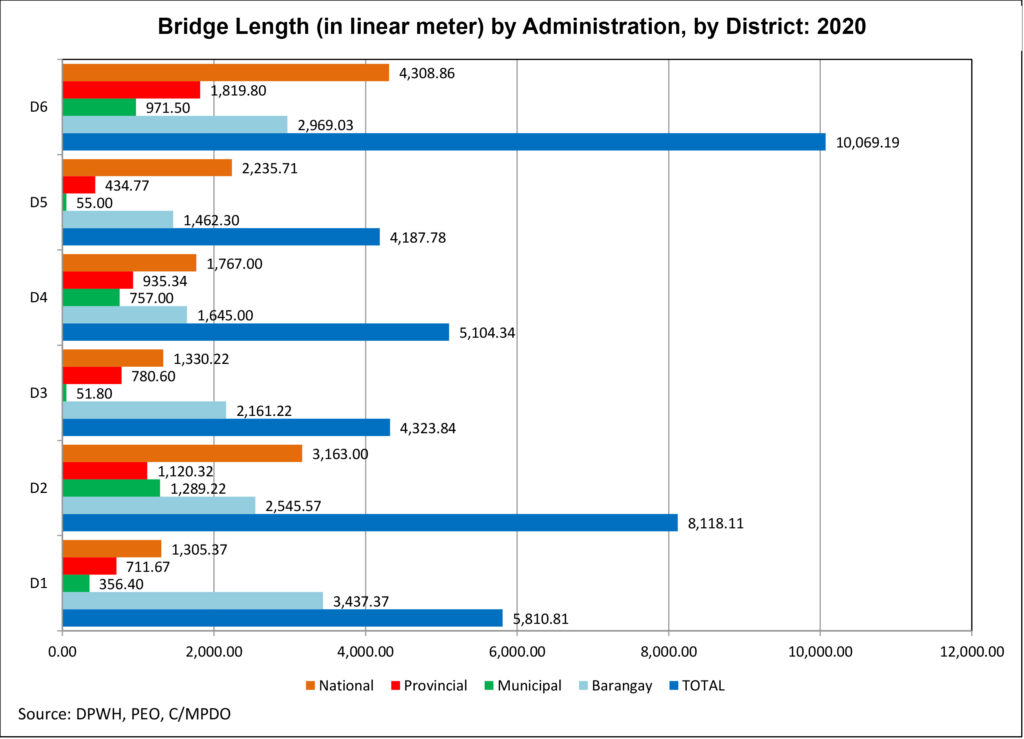
All national and provincial bridges are already made of permanent structures. Municipal and Barangay Bridges with permanent structures are recorded at 13,394.93 linear meters or about 75.67% of the total Municipal and Barangay bridge length, while the remaining 4,306.48 linear meters or 24.33% are still made up of temporary structures.
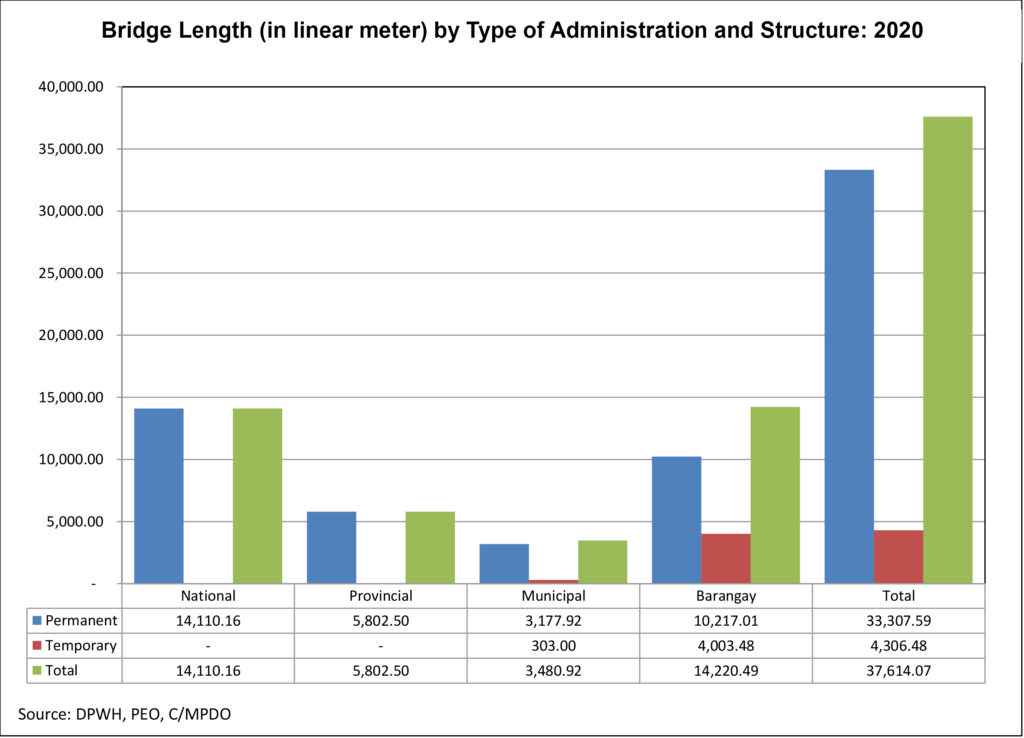
Irrigation System
For the year 2019, the irrigation coverage of the province was placed at 57% representing 105,662 hectares irrigated from the potential irrigable area of 185,542 hectares.
Domestic Water Supply
Potable water supply is being served by the 48 water districts/waterworks associations and privately-owned water associations located in different parts of the province catering to various clients namely; residential, commercial and industrial. Residential had the highest connections with 234,424, an increase of 3.53% or 7,990 connections over the previous year’s figure of 226,434. Meanwhile, commercial and industrial/government had 12,752 and 2,738 connections, respectively.
Among the water service provider, Dagupan City Water District exhibited the highest residential connections with 24,784 consumers, followed by Alaminos City with 16,399 connections and Mangaldan with 13,401. In terms of water consumption for all types of client, Dagupan City Water District likewise registered the highest with a total of 7,153,917 cubic meters, followed by Alaminos City Water District with 4,646,509 cubic meters and Mangaldan Water District with 3,616,565 cubic meters.
Of the forty-eight (48) cities/municipalities of the province, five (5) municipalities (Aguilar, Labrador, Sison, Natividad and Bautista) have no existing water district or waterworks system within their municipality.
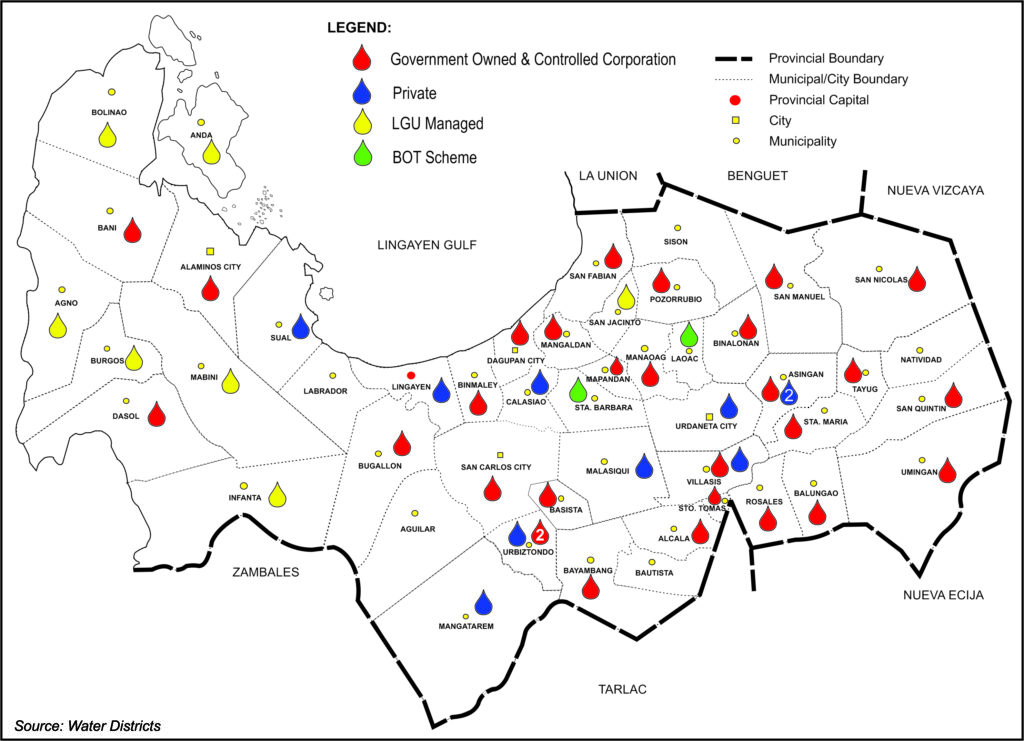
Electric Power Supply
One hundred percent (100%) of the barangays in Pangasinan have been energized. However, out of 679,700 potential household connections, some 692,500 or about 102% have been energized. Percentage of energization (HHs) exceed by 2% due to data used be electric coops under Potential Households.
The province has 2 power generation plants, the Sual Coal-Fired Power Plant and the San Roque Hydro Power Plant located in the municipalities of Sual and San Manuel, respectively. These power plants have a combined generating capacity of 1,545MW and have several transmission lines carrying high voltage of 69 KV, 230 KV and 500 KV.
There are five (5) electric cooperatives providing electrical services in the province, namely: Pangasinan Electric Coops I and III (PANELCO I & III), Central Pangasinan Electric Coop (CENPELCO), Dagupan Electric Corporation (DECorp), and the La Union Electric Coop (LUELCO). The latter provides electrical services to some barangays of San Jacinto, San Fabian and Sison. The cost per kilowatt hour of the different Electric Cooperatives varies by type of consumers. For residential, LUELCO has the highest rate/kwh with P10.14, followed by CENPELCO and PANELCO III with Php9.26 and Php9.23, respectively.
As to consumption, household connections posted the highest consumption at 863,621,479 kwh, with an average consumption of 1,425 kwh per household. On the other hand, Street Light end users have the least number of connections registering a total consumption of 31,366,266 kwh.
Transport Facilities
A total of 291,557 motor vehicles were registered in CY 2020, which had increased by 5.48% or 15,143 vehicles compared to last year’s figure of 276,414 registered motor vehicles. By vehicle classification, private vehicles recorded the highest number of registrations with 247,962 vehicles or about 85.04% of the total registered vehicles, followed by vehicles “for hire” with 41,603 vehicles or 14.27%, and government vehicles with only 1,409 vehicles or 0.48%.

For the various types of motor vehicles, motorcycle/tricycle always posted the highest number of registrations with this year’s 195,831 or almost 67.17% of the total number vehicles registered. This is followed by the utility vehicles with 48,745 or 16.72%, cars with 23,837 or 8.18%, sports utility vehicles with 13,722 or 4.71%, trucks with 8,712 or 2.99%, and trailers with 583 or 0.20%. Posted with the least registration are buses with only 127 or 0.04% of the total registered vehicles.
Out of the total registered motor vehicles, 231,114 or 79.27% are using gasoline, while 59,860 or 20.53% use diesel. Compared to last year’s data of 219,065 and 56,816 vehicles using gasoline and diesel, respectively, an increase of 5.50% and 5.36% respectively, was noted.
Communication Facilities
Postal services are being provided by the 50 post offices giving more than 100% coverage for the province. For the year under review, one (1) post office served 62,744 individuals. For the same period, there are 107 letter carriers in the province, serving 29,319 persons per letter carrier. The ratios of both the post office and the letter carrier to population are below the standard ratio of 1:6000 and 1:5000, respectively.
Also providing information services in the province are 19 print local publications, 16 existing cable stations and 20 broadcast/radio stations.
The province is fully served with telephone services provided by PLDT making it at 100% coverage. A total of 111,688 have been installed province wide, making a telephone density of 3.56 for every 100 persons for the year under review.
In terms of electronic services, the province had 8 Internet Service Provider (ISP) facilities mostly located in the cities of Dagupan, Urdaneta and San Carlos. In addition, numerous Internet Cafés installed provincewide are likewise providing internet services to the public.
Solid Waste Disposal
In disposing of solid wastes, there were 14 LGUs using open dumpsite, four (4) or almost 8.33% of the total number of municipalities/cities use the Controlled Dumpsite Facility and only four (4) use Sanitary Landfill Facility, namely: Bolinao, Burgos, Alaminos City, and Urdaneta City. The Municipality of Sto.Tomas is the only LGU that has no dumpsite, but has MRF in all its barangays.
From the total number of barangays in the province (1,364), only 713 or 52.3% have Material Recovery Facilities (MRF), which is far behind the standard of 1 MRF for every barangay. In addition, thirty-six (36) Central MRF are established in some local government units in the province, which are funded by the National Solid Waste Management Commission (NSWMC), while one (1) is LGU-initiated (San Fabian). The municipalities of Agno, Bolinao, Mabini, Bugallon, San Carlos City, Pozzorubio, Villasis, Asingan, Natividad, Rosales, San Quintin, Bautista, San Nicolas, Umingan and Sto.Tomas have 100% compliance in the establishment of MRF in every barangay.
Slaughterhouse
Among the forty-eight (48) municipalities/cities of the province, forty one (41) have existing slaughterhouse, which shows that seven (7) or 15% of the total number of local government units have no slaughterhouse.
Public Market
All the municipalities and cities of Pangasinan have their own public markets.
Ports
Based from the Philippine Ports Authority (PPA) data, the province has six (6) registered ports, of which, five (5) are temporary/non-commercial ports, which handle their own cargoes/products, and the Sual Government Port that handles commercial cargoes, but can only accommodate small vessels at present.
A total of 246 domestic and foreign ship calls were recorded at the various ports and anchorages in the province. More than half of which, or 158 vessels were reported to have called/arrived at the Team Sual Corporation, and 29 at the Sual Government Port.
The total volume of cargo discharged and loaded is 2,782,549 metric tons. Bulk of which is from Team Sual Corporation with 2,531,475 metric tons, while the remaining are from the Pryce Gases, Inc., Macroserve Mining, Inc., and Sual Government Port.


